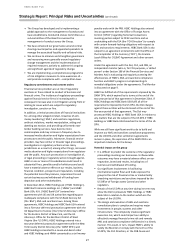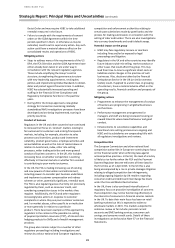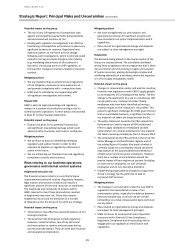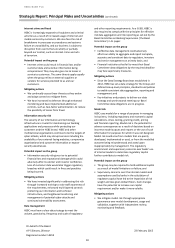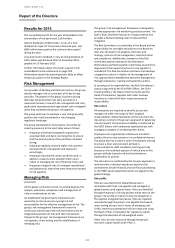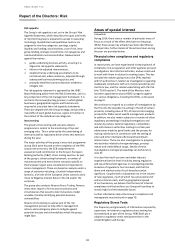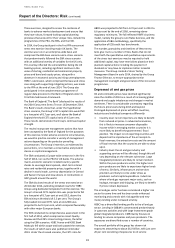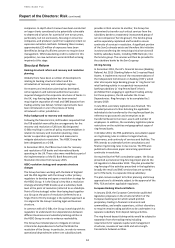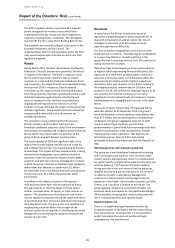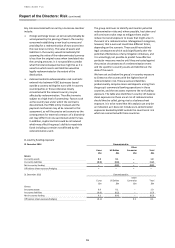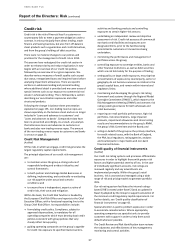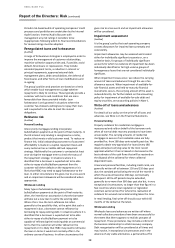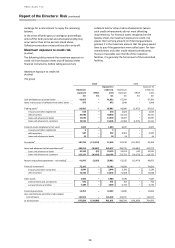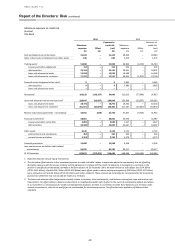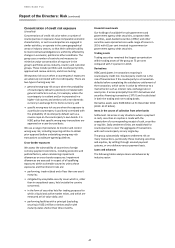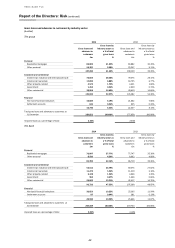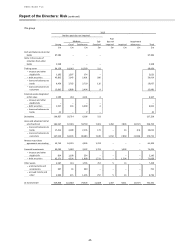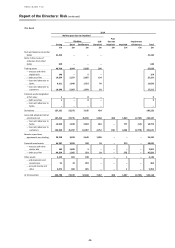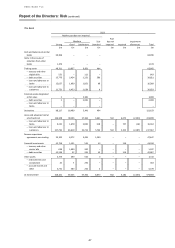HSBC 2014 Annual Report Download - page 39
Download and view the complete annual report
Please find page 39 of the 2014 HSBC annual report below. You can navigate through the pages in the report by either clicking on the pages listed below, or by using the keyword search tool below to find specific information within the annual report.
HSBC BANK PLC
Report of the Directors: Risk (continued)
37
Credit risk
Credit risk is the risk of financial loss if a customer or
counterparty fails to meet a payment obligation under a
contract. It arises principally from direct lending, trade
finance and leasing business, but also from off-balance
sheet products such as guarantees and credit derivatives,
and from the group’s holdings of debt securities.
There were no material changes to our policies and
practices for the management of credit risk in 2014.
This year we have redesigned the credit risk section in
order to enhance clarity and reduce duplication. It now
begins with an overview of our credit risk policies
followed by an overview of our gross exposures. We
describe various measures of credit quality such as past
due status, renegotiated loans and impaired loans before
analysing impairment allowances. There are specific
sections on wholesale lending and personal lending
where additional detail is provided and we cover areas of
special interest such as our exposure to commercial real
estate in wholesale lending. This is followed by a section
describing our securitisation exposures and other
structured products.
Following the change in balance sheet presentation
explained on page 155, non-trading reverse repos are
shown separately on the balance sheet and are no longer
included in ‘Loans and advances to customers’ and
‘Loans and advances to banks’. Comparative data have
been re-presented accordingly. As a result, any analysis
that references loans and advances to customers or
banks excludes non-trading reverse repos. The amount
of the non-trading reverse repos to customers and banks
is set out on page 55.
Credit Risk Management
(Audited)
Of the risks in which we engage, credit risk generates the
largest regulatory capital requirements.
The principal objectives of our credit risk management
are:
• to maintain across the group a strong culture of
responsible lending and a robust risk policy and
control framework;
• to both partner and challenge Global Businesses in
defining, implementing, and continually re-evaluating
our risk appetite under actual and scenario
conditions; and
• to ensure there is independent, expert scrutiny of
credit risks, their costs and mitigation.
Within the bank, the Credit Risk function is headed by
the European Chief Risk Officer and reports to the Chief
Executive Officer, with a functional reporting line to the
Group Chief Risk Officer. Its responsibilities include:
• formulating credit policy. Compliance, subject to
approved dispensations, is mandatory for all
operating companies which must develop local credit
policies consistent with group policies that very
closely reflect Group policy;
• guiding operating companies on the group’s appetite
for credit risk exposure to specified market sectors,
activities and banking products and controlling
exposures to certain higher-risk sectors;
• undertaking an independent review and objective
assessment of risk. Credit risk assesses all commercial
non-bank credit facilities and exposures over
designated limits, prior to the facilities being
committed to customers or transactions being
undertaken;
• monitoring the performance and management of
portfolios across the group;
• controlling exposure to sovereign entities, banks and
other financial institutions, as well as debt securities
which are not held solely for the purpose of trading;
• setting policy on large credit exposures, ensuring that
concentrations of exposure by counterparty, sector or
geography do not become excessive in relation to the
group’s capital base, and remain within internal and
regulatory limits;
• maintaining and developing the group’s risk rating
framework and systems through the Regional Model
Oversight Committees (‘RMOC’), which report to the
Risk Management Meeting (‘RMM’) and oversees risk
rating system governance for both wholesale and
retail businesses;
• reporting on retail portfolio performance, high risk
portfolios, risk concentrations, large impaired
accounts, impairment allowances and stress testing
results and recommendations to the group’s RMM,
the group’s Risk Committee and the Board; and
• acting on behalf of the group as the primary interface,
for credit-related issues, with the Bank of England,
the PRA, local regulators, rating agencies, analysts
and counterparts in major banks and non-bank
financial institutions.
Credit quality of financial instruments
(Audited)
Our credit risk rating systems and processes differentiate
exposures in order to highlight those with greater risk
factors and higher potential severity of loss. In the case
of individually significant accounts, risk ratings are
reviewed regularly and any amendments are
implemented promptly. Within the group’s retail
business, risk is assessed and managed using a wide
range of risk and pricing models to generate portfolio
data.
Our risk rating system facilitates the internal ratings-
based (‘IRB’) created under Basel 2 (and as updated in
Basel 3) adopted by the Group to support calculation of
the minimum credit regulatory capital requirement. For
further details, see ‘Credit quality classification of
financial instruments’ on page 43.
Special attention is paid to problem exposures in order
to accelerate remedial action. Where appropriate,
operating companies use specialist units to provide
customers with support in order to help them avoid
default wherever possible.
The Credit Review and Risk Identification team reviews
the robustness and effectiveness of key management,
monitoring and control activities.


